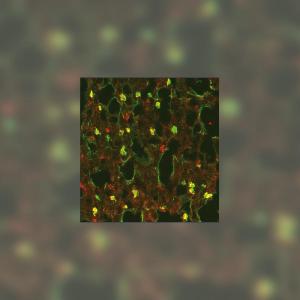COPD: Ion channel regulates molecule that contributes to disease
14 Jan 2022
Researchers reveal that the recycling of a disease-promoting molecule through a specific ion channel is impaired in patients with the lung disease COPD.
14 Jan 2022
Researchers reveal that the recycling of a disease-promoting molecule through a specific ion channel is impaired in patients with the lung disease COPD.

Immunofluorescence image of lung tissue showing co-localization of TRPML3 (green) and macrophages (red). Source: Barbara Spix
Chronic obstructive pulmonary disease – COPD for short – is one of the most common diseases of the lung. It affects almost 300 million people worldwide, of which about three million die every year. A collective term for chronic obstructive bronchitis and pulmonary emphysema, COPD develops primarily as a response to environmental toxins – particularly cigarette smoke – or due to genetic defects. LMU pharmacologist Prof. Christian Grimm from the Walther Straub Institute of Pharmacology and Toxicology has now been able to demonstrate, in collaboration with Prof. Martin Biel (Department of Pharmacy) and Dr. Ali Önder Yildirim (Helmholtz Zentrum München), that specific ion channels in immune cells play a decisive role in the inflammation process. According to the scientists, these ion channels could potentially be targets for new therapies.
Alveolar macrophages are immune cells that occur on the surface of pulmonary alveoli. They secrete various inflammatory mediators, including the so-called macrophage elastase MMP12. It was already known that an excess of this molecule contributes to the development of pulmonary emphysemas. As the scientists have now been able to show in two independent mouse models, the ion channel TRPML3 plays a major role in the regulation of MMP12: In the lung, the channel occurs almost exclusively in alveolar macrophages. When it was inactivated, the corresponding knockout mice had elevated MMP12 levels in the lung. Lung function tests confirmed consequential lung damage, which deteriorated following treatment with tobacco smoke or elastase, both of which contribute to the development of COPD.
Using various methods, the researchers subsequently investigated the expression and function of TRPML3 in the lung in order to clarify how the MMP12 concentration is regulated. “To our surprise, we found that it is not the secretion of MMP12 that is impaired in COPD, but the endocytosis. As such, it is not that the inflammation causes more MMP12 to be released, but that the reabsorption of excess MMP12 by TRPML3 does not work well enough,” says Grimm. “This is further supported by our demonstrating, with the aid of endolysosomal patch clamp technology, that the channel is expressed above all in the so-called early endosomes, whose job it is to absorb particles.”
A comparison of specimens from human patients with and without COPD showed that TRPML3 is very strongly upregulated in COPD patients – i.e. much more of it is produced. The scientists assume that the body tries in this way to counteract harmful influences by breaking down as much of the damaging MMP12 as possible. Overall, therefore, the results indicated that TRPML3 is an important regulator of MMP-12 absorption through alveolar macrophages and could serve as a therapeutic target for COPD.
Barbara Spix, Elisabeth S. Butz, Cheng-Chang Chen, Anna Scotto Rosato, Rachel Tang, Aicha Jeridi, Veronika Kudrina, Eva Plesch, Philipp Wartenberg, Elisabeth Arlt, Daria Briukhovetska, Meshal Ansari, Gizem Günes Günsel, Thomas M. Conlon, Amanda Wyatt, Sandra Wetzel, Daniel Teupser, Lesca M. Holdt, Fabien Ectors, Ingrid Boekhoff, Ulrich Boehm, Jaime García-Añoveros, Paul Saftig, Martin Giera, Sebastian Kobold, Herbert B. Schiller, Susanna Zierler, Thomas Gudermann, Christian Wahl-Schott, Franz Bracher, Ali Önder Yildirim, Martin Biel, Christian Grimm: Lung emphysema and impaired macrophage elastase clearance in mucolipin 3 deficient mice. Nature Communications 2022